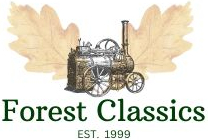The steam shop
Blog
The History of Wilesco Steam Engines: From Toy to Timeless Icon
For more than a century, miniature steam engines have captured the imagination of hobbyists, collectors, and children alike. Among the most iconic producers of these delightful machines is Wilesco, a German company that has become synonymous with model steam engineering. With roots reaching back to the 1910s, Wilesco's journey from simple metal goods to high-quality working steam models is as fascinating as the engines themselves. This post dives deep into the history of Wilesco steam engines, tracing their origins, technological evolution, cultural impact, and ongoing legacy in the 21st century. Origins: Wilhelm Schröder and the Birth of WilescoThe story of Wilesco begins in 1912, in the industrial heartland of Germany—Lüdenscheid, in North Rhine-Westphalia. The company was founded by Wilhelm Schröder, and its name—Wilesco—is derived from Wilhelm Schröder & Co. Initially, Wilesco produced aluminum household goods such as forks, spoons, and other kitchenware. At the time, aluminum was still relatively new as a consumer material, and its lightness and corrosion resistance made it popular. Wilesco's early success was built on high-quality metal craftsmanship—skills that would later prove invaluable in precision-engineering steam models. As with many European manufacturers, the World Wars had a profound effect on the company. During both World War I and World War II, Wilesco adapted to meet wartime production needs, but the aftermath of WWII presented a challenge: how to transition back to peacetime goods in a recovering Europe. A Pivot to Play: The Birth of Wilesco Steam ModelsBy the early 1950s, the European economy was stabilizing, and consumer demand was shifting from pure utility to entertainment and education. Around this time, Wilesco made a bold move that would define its future: the company began manufacturing miniature, working steam engines. This pivot was not entirely without precedent. Germany had long been a hub for precision toy engineering, with companies like Bing, Märklin, and Fleischmann already having produced steam toys in the early 20th century. Wilesco sought to improve upon these ideas with durable materials, greater realism, and user-friendly operation. In 1950, Wilesco took their first stationary steam engines to market. These early models like the D32 EL, laid the foundation for a whole line of products that blended educational value with the fascination of mechanical movement. Unlike electric toys, these engines were powered by solid fuel (hexamine tablets), and later, Esbit dry fuel, enabling real steam generation and piston movement. The Golden Era: 1950s–1970sThe post-war period marked a boom in mechanical toys, and Wilesco’s steam engines quickly gained popularity in Germany and abroad. By the 1960s, Wilesco had developed a comprehensive line of stationary engines, which they branded with designations like D5, D6, D10, D16, and the flagship D36 "Old Smokey Steamroller"—a mobile steam model introduced in 1966 that captivated young and old alike. Features and CraftsmanshipWilesco's models were more than just toys—they were functional replicas of real steam engines. Made mostly of brass, aluminum, and steel, each engine featured a working boiler, safety valve, flywheel, whistle, and sometimes even a dynamo to generate electricity. Steam was generated via a small water boiler, heated by burning Esbit fuel tablets placed under the boiler. As steam pressure built up, it would drive the piston, which turned a flywheel and, through a drive belt, powered various accessories like grindstones, pumps, and saws. The attention to detail and mechanical accuracy made Wilesco steam engines popular not just among children, but among engineering students, educators, and model engineers as well. Accessories and Workshop SetsOne of Wilesco’s unique strengths was the creation of miniature workshops—sets that allowed users to simulate entire factory environments. Accessories like:
…could all be powered by the same steam engine via pulley belts. This created an interactive learning experience about the principles of steam power, friction, torque, and mechanical energy transfer. Exporting Steam: The Global Reach of WilescoWhile Germany remained the core market, Wilesco’s reputation spread rapidly during the 1960s and 70s. Their products were exported across Europe, the United States, and parts of Asia. In many countries, Wilesco steam engines were sold through hobby stores, science education retailers, and even department stores. For many American and British children, owning a Wilesco engine became a rite of passage into the world of mechanics and physics. Their appeal extended far beyond the toy market. In schools, Wilesco engines were frequently used to demonstrate thermodynamics and basic engineering principles, fostering an appreciation for Science, Technology, Engineering, and Mathematics (STEM) long before such programs were formally structured. Surviving the Electronic Revolution: 1980s–1990sThe 1980s saw a dramatic shift in the toy industry. The rise of video games, remote-controlled cars, and microelectronics began to eclipse traditional mechanical toys. Yet Wilesco managed to survive this paradigm shift. Why?
In addition, Wilesco introduced new models, including variants with electric heating elements (safer and more convenient than solid fuel), and incorporated more complex mechanics, such as twin-cylinder engines and mobile vehicles. Into the 21st Century: Adaptation and LegacyThe early 2000s brought new challenges and new opportunities. With the global rise of maker culture and renewed interest in hands-on STEM education, Wilesco found itself in a renaissance. Modern Innovations
Wilesco also embraced online sales, making their products available through e-commerce platforms worldwide. Today, hobbyists from Tokyo to Toronto can purchase and operate Wilesco steam engines with ease. Cultural and Educational ImpactWilesco steam engines represent more than nostalgia or mechanical charm—they're a bridge between the past and the future of engineering. In Education
In Pop CultureAlthough not often center stage, Wilesco engines have made cameo appearances in:
Why Wilesco EnduresAt a glance, Wilesco’s steam engines might appear to be relics of a bygone era—but in truth, their enduring popularity is rooted in a few key factors:
Looking Ahead: The Future of WilescoAt the time of writing, Wilesco continues to manufacture its iconic steam engines in Lüdenscheid. While new trends in renewable energy, smart toys, and robotics dominate headlines, Wilesco quietly holds its ground, appealing to a loyal audience of engineers, educators, and dreamers. Future opportunities for Wilesco may include:
Whatever the path forward, Wilesco’s legacy is secure. In an age of digital everything, these miniature steam engines stand as a tribute to the marvels of analog invention. ConclusionFrom humble beginnings as an aluminum goods producer in pre-WWI Germany to becoming a global icon of model engineering, Wilesco has carved out a unique and enduring legacy. Their steam engines continue to inspire curiosity, creativity, and a love of mechanics across generations. Whether you’re a collector admiring the brass gleam of a Wilesco D3, a student watching steam turn into motion, or a parent passing down a cherished model, Wilesco engines remind us of a timeless truth: there’s beauty in how things work.
|
Blog SearchPopular ArticlesTopicsAbout the Authors |




















